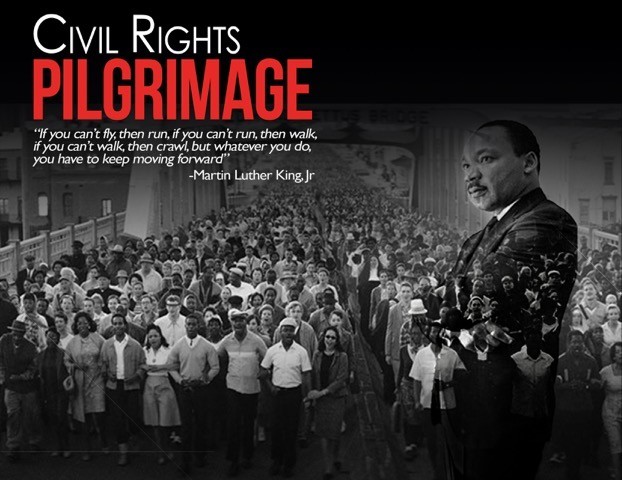By: Candi Bolden
Spending spring break with 30 to 35 people on bus might not seem ideal, but for senior Michelle Anderson it is.
“It’s the best way you can spend your spring break,” Anderson said.
Leaving March 6 and returning March 14, Anderson along with other students in PLSC 4334 and SOSC 6356 are trading in their spring break to go on a Civil Rights Pilgrimage across four states.

According to Anderson, the Civil Rights Pilgrimage connects students to history by sharing first hand stories of the past with students. For her, that makes history more tangible. Anderson, who is the student trip leader for the pilgrimage, helps students process their experiences on the trip by leading discussions.
“Every person has what our coordinator calls their ‘a-ha moment’ and it’s the moment of them just kind of getting why it’s such a big deal and why it’s important and why we go to these places,” Anderson said. “For me that was meeting all of what we call ‘the foot soldiers.’”
The “foot soldiers” are various members of the Civil Rights Movement that lead the tour of areas on the pilgrimage. In past years students met such “foot soldiers” as Montgomery Bus Boycott participants, the Harris Family, former freedom riders and more. For Anderson, one of the standouts is Joanne Bland, who marched in the Bloody Sunday March when she was 11 years old.
“She is the tour guide that we had through Selma and she’s really raw about the experience that she had. I think that makes it real for a lot of people,” Anderson said.
But the Pilgrimage is more than listening to the stories of those involved in the Civil Rights Movement and visiting the site’s major events in the movement. The students write journals of their experiences on the pilgrimage
“The pilgrimage is not a tour. We meet and interact with the ‘foot soldiers’ of the movement at virtually every stop,” Civil Rights Pilgrimage faculty leader Dennis Simon said.
The pilgrimage itself focuses on areas Simon defines as “ground zero” of the Civil Rights Movement. This includes Little Rock, Ark.; Jackson, Miss.; Philadelphia; Oxford, Miss.; Selma, Ala.; Montgomery, Ala.; Tuskegee, Ala.; Birmingham, Ala.; and Memphis, Tenn.
“This year we will be in Selma, Alabama for the 50th anniversary of Bloody Sunday which led to the introduction and passage of the Voting Rights Act of 1965,” Simon said.
In Selma, Ala. the group will march across the Edmund Pettus Bridge for a Bloody Sunday reenactment. According to Simon, immersion like this allows students to experience the movement more personally.
“Students learn the politics and then relive, so to speak, American history,” Simon said.
The trip itself is run by the Chaplain’s Office. Simon, Anderson and Ray Jordan serve as trip leaders.
Simon has run the trip since 2008 after designing a course, Politics and Legacies of the Civil Rights Movement, to go along with the trip.
The Civil Rights Pilgrimage is held only during the spring semester.









